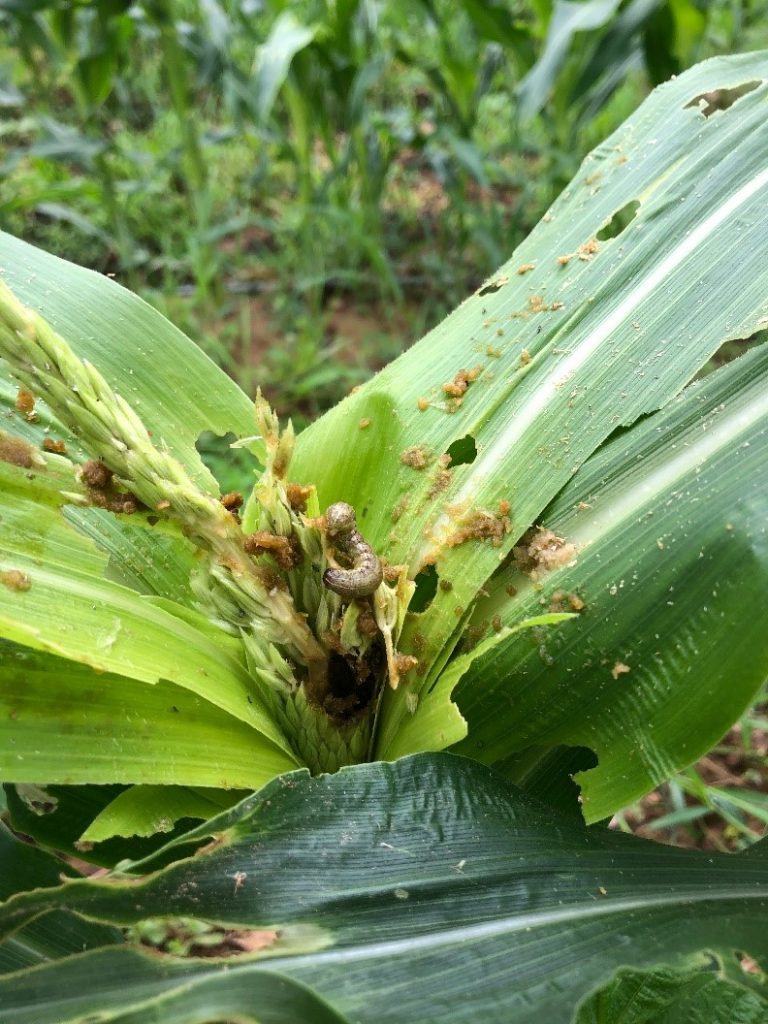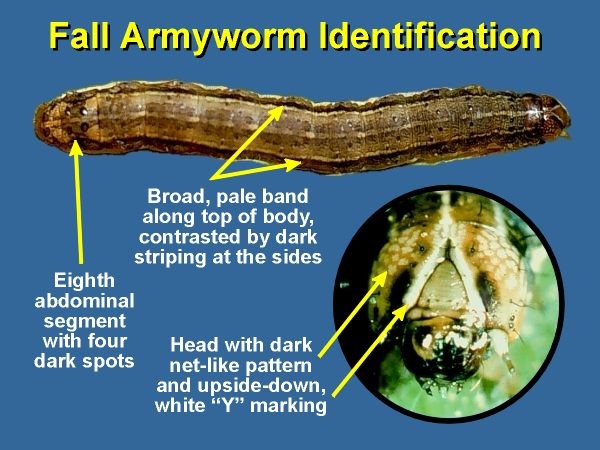By Kyle Bekelja (postdoc), Tom Kuhar (Professor), and Sally Taylor (Associate Professor) Department of Entomology, Virginia Tech
We installed our pheromone bucket traps for fall armyworm in late July at Homefield Farm in Whitethorne, VA and we caught moths the first week (8 per trap). This alerted us that this tropical moth pest had already reached southwest Virginia. Then, this week, August 16, 2022, we noticed a pretty bad infestation of FAW larvae in our sweet corn at this same location.

The Pest. Fall armyworm (FAW) is a moth pest that migrates northward during late summer and early fall. Be on the lookout for this pest especially during times of northerly winds (such as tropical storms) which can carry female moths to Virginia late in the season. Fall armyworms have a wider host range that includes more than 80 plants: vegetables include sweet corn, tomatoes, and peppers, field and forage crops such as alfalfa, cotton, and peanuts, and ornamental commodities, especially turfgrass. Last year, FAW hit turfgrass hard in Virginia; this year, we have already started seeing it in sweet corn. Based on observations from Dr. Scott Stewart in Tennessee, we believe that this strain of FAW favors corn and is likely not going to be a huge turf pest like we saw in fall 2021.
Identification
Be on the lookout for shotgun-patterned damage and lots of frass (i.e., poop) in the corn whorl, shown in Figure 1 (we noticed feeding that was concentrated on un-emerged tassels). If you dig deep inside the whorl, you’re likely to find a caterpillar with the telltale inverted “Y” on its forehead, and four black dots at the tail-end of the abdomen, shown in Figure 2.

Treatment Evaluation. We collected FAW caterpillars from sweet corn at Homefield Farm in Blacksburg, VA on August 16, 2022, and assessed percent mortality using treatments listed in Table 1. We placed caterpillars in 1-ounce cups with corn tassels that were dipped into solutions of treatments, and assessed mortality after 24-hours. All treatments provided good control compared to a water check. Although the pyrethroid lambda-cyhalothrin resulted in over 83% mortality of FAW, the two products that combine the diamide chlorantraniliprole with pyrethroids (Beseige and Elevest) resulted in 100% mortality after 24 hours.
Insecticide bioassay Results of field-collected fall armyworm larvae.

Control. Insecticides recommended for controlling FAW include pyrethroids (such as Lambda-Cyhalothrin, bifenthrin, and others) and more selective caterpillar-targeting insecticides such as Prevathon, Coragen, and Acelepryn. Consider using some of these more selective options during times when pollinators are more active (e.g., while sweet corn is tasseling). Consult the relevant pest management guides for specific recommendations on various commodities. Remember that control of large caterpillars is often difficult with any insecticide.
